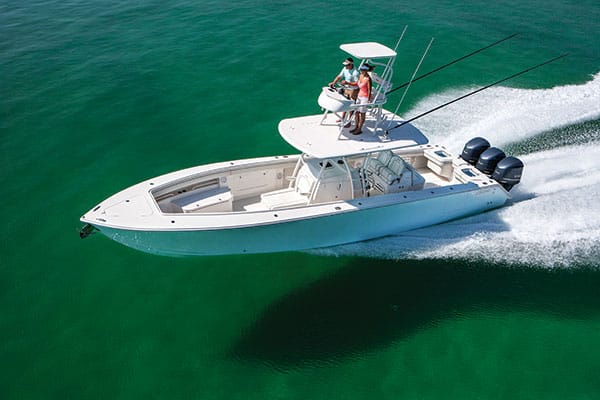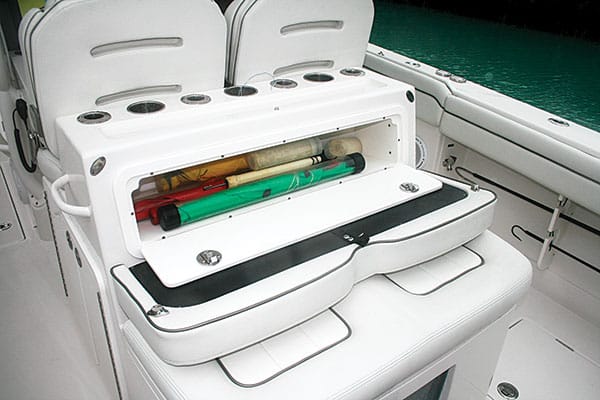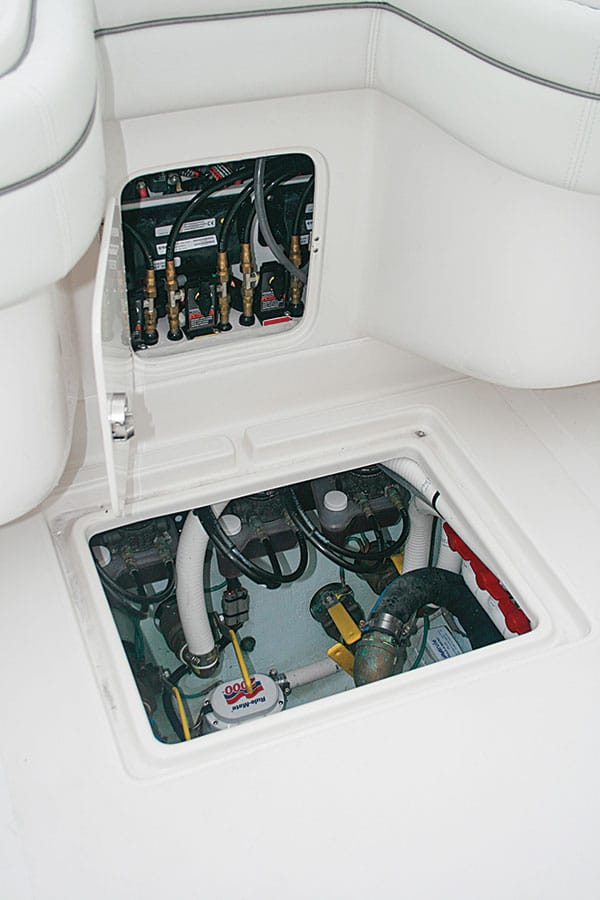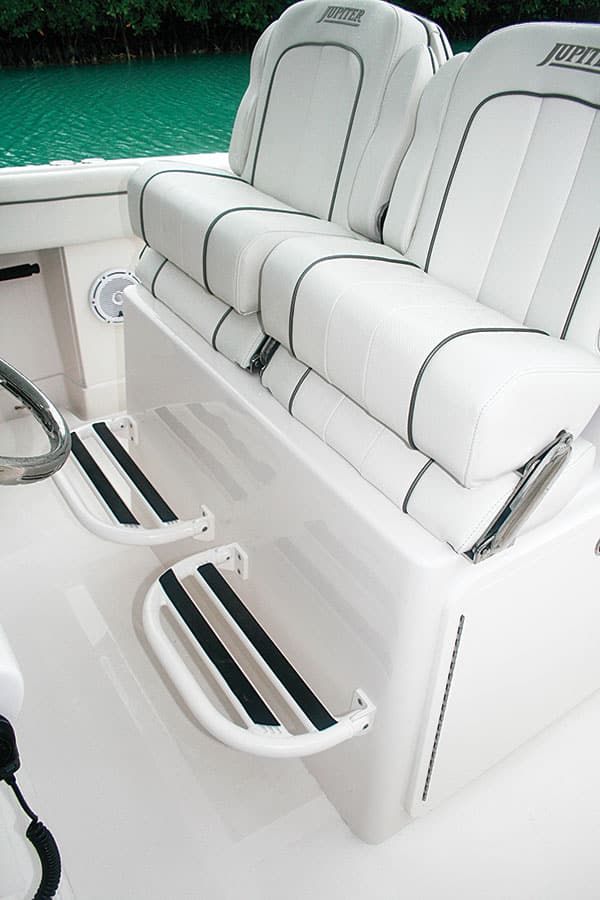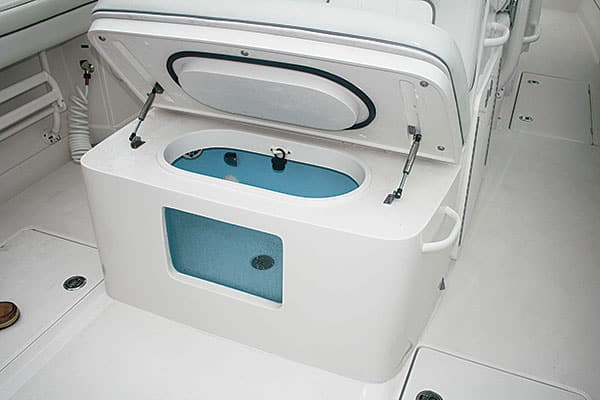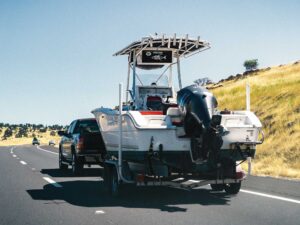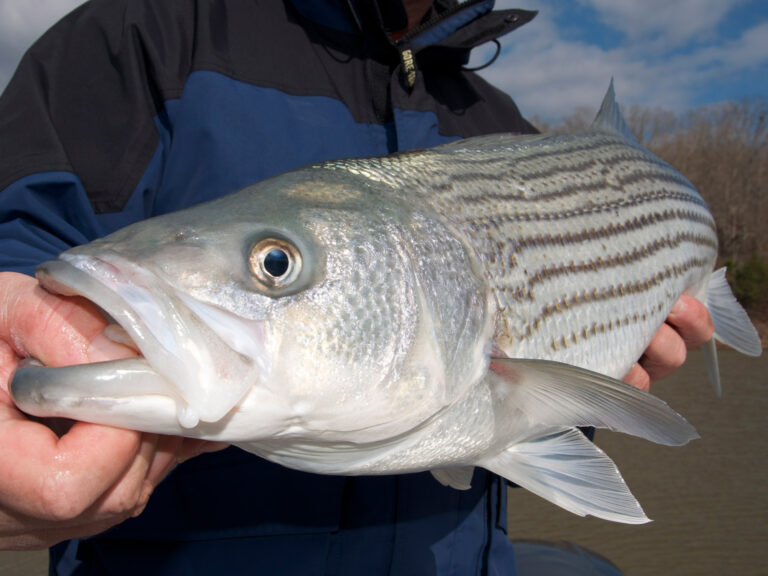The Jupiter Marine 38 ranks as one the most formidable fishing machines you will encounter. Its size, angling amenities, attention to detail, and wave-taming Donald Blount-designed hull have earned praise and respect from serious saltwater anglers.
Yet, that wasn’t quite good enough for the folks at Islamorada-based Caribee Boat Sales, a leading Jupiter dealer. They wanted their own special version of the 38, with greater live-bait capacity and a few more creature comforts. Jupiter Marine agreed to build this, the Caribee edition.
As I boarded with Caribee’s Bill Gilbert on a drizzly January morning, my attention was drawn immediately to the transom bulkhead design. The Caribee edition features a pair of 38-gallon livewells built into the stern. Interestingly, the bottom of each livewell does not extend all the way to the deck, stopping a few inches short and offering a bit of toe room under each.
“We believe you can never have too much live bait,” Gilbert said, “so we asked Jupiter to add these livewells in the transom.”
In between the livewells is an alcove of sorts where an angler can brace himself while fishing astern. A beefy side door on the port side of the aft cockpit offers easy boarding. Coaming bolsters encircle the interior to cushion your thighs and knees while fighting fish.
The Caribee edition also features an expanded seating module that includes a pair of comfortable aft-facing seats. Underneath these seats resides a third, 40-gallon livewell (with an aft-facing aquarium-style window to check on baits) and tackle-storage behind the backrest.
A pair of forward-facing helm seats feature fold-down armrests and flip-up bolsters. Fold-out footrests below each add a measure of comfort. The seating console includes cabinets along both sides with room for 10 plastic tackle boxes in each.
Our test boat featured a hardtop with a pair of outriggers, a Garmin open-array radar, a rack for storing six rods, and a second station, accessible via a hatch and integral ladder on the portside of the top.
The center console extends forward with a hatch that lifts to reveal additional dry storage inside. With the hatch closed, the console extension becomes an inviting lounge.
Inside the console resides a permanent toilet, sink with a freshwater faucet, and access from behind to the immaculate helm rigging and batteries. I also discovered a shelf and bungee-cord system for conveniently storing fishing kites.
The foredeck of the Caribee edition offers a pair of elevated pods on either side of the foredeck. Not only do these offer storage inside, but with the addition of snap-on cushions and slide-in backrests, you also get a pair of lounges.
Two additional storage compartments integrated into the inwales forward include special racks for hanging dock lines. A pair of in-sole lockers flank the center console with racks for storing four rods in each.
To keep the bow free of snag points, the Lewmar ProFish windlass sits inside the bow hatch, and the anchor line feeds through a roller integrated into the bow stem. A fold-down step on the forward bulkhead eases access to the bow deck, with pair of pop-up stainless cleats for tying off.
The 38 features a pair of big-boat style hawse pipes in the stern quarters and again amidships, leading to heavy-duty cleats underneath. No less than eight gunwale rod holders punctuate each side of the Caribee edition.
The helm of the our test boat featured a pair of flush-mounted Garmin 8215 multifunction displays with networked sonar, GPS/chart plotters and radar; a Garmin autopilot control head; and Yamaha’s Helm Master System with power steering, digital throttle and shift, joystick low-speed steering control; and Command Link Plus engine monitor. We found the joystick particularly useful as we pulled away from the dock during the blustery conditions on test day.
Our test boat was powered by a trio of Yamaha F300 outboards, which idled down to about 550 rpm in gear, nudging the Caribee along at about 1.2 mph — perfect for slow-trolling live baits for sailfish.
When it came time to throttle up, the triple 300s brought the 38-footer to plane in 5.5 seconds and to 30 mph in 7.1 seconds en route to a top speed of 58 mph. Best fuel economy occurred at 3,500 rpm and 29 mph, where the of F300s collectively burned 28.4 gph, achieving 1.02 mpg, which equates to a range of nearly 500 miles with the Caribee’s 485-gallon fuel tank.
The 38’s deep-V hull sliced with ease and confidence through the 3-foot waves on test day, with nary a rattle or creak, telling me that it could take on much bigger seas. Cornering was precise and predictable. The clear polycarbonate enclosure that wrapped around the helm protected us from the wind and rain.
The Jupiter 38 stands as one of the most admired fishing machines on the market today. The new Caribee edition will enhance that reputation.
Jupiter Marine • 941-729-5000
